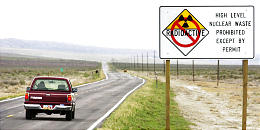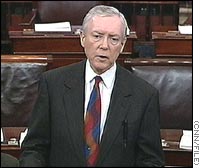PFS nuclear waste site approved — LAST WEEK
February 23rd, 2006

This is really about Yucca Mountain and PFS – it’s Nuclear Waste Daze all over again.
There’s a Minnesota delegation out in Nevada today touring Yucca Mountain, 4 members of the Red Wing City Council, members of the Prairie Island Indian Community Tribal Council, and Representatives and Senators who are on the Legislative Electric Energy Task Force. When I tell people about this they laugh, and say “WHY????”
Yesterday on MPR, it was annouced that NSP’s Private Fuel Storage (PFS) in Utah was licenced by the Nuclear Regulatory Commission for Part 72 storage of high level nuclear waste. It’s not been reported in any other Minnesota media outlet. Problem is, this happened last week. Problem is, it was announced at the very moment that a plane landed in Nevada carrying a delegation from Red Wing’s City Council, Prairie Island’s Tribal Council and the Minnesota Legislature. They don’t know about PFS. I checked with Red Wing Council members Peterson and Cook and they did not know anything at all about PFS, and Kay Kuhlman, City Administrator, did not know it had been approved until I’d told her last week. Hmmmmmmmmm…
Today’s questions:
1) Why is news of PFS licensing delayed in this area?
2) Why is Xcel, the lead utility in PFS, backing off of supporting it?
3) Why is Xcel encouraging Minnesotans to lobby in Nevada for nuclear waste storage in Yucca?
Any thought that Yucca is going to happen is delusional, and the DOE and NRC said so and were quoted in the New York Times last week! Red Wing, my home town, is going to have to deal with OUR problem.
Xcel is withholding their funding? Yup, here’s their letter: View image
And here’s one from Southern withdrawing completely: View image
FYI, here’s the Private Fuel Storage site
Here’s the Skull Valley Goshute’s site.
Here’s the State of Utah’s site.
Here’s Ken Verdoia’s documentary about Skull Valley
And Joan Marshman, of the Florence Town Board, tells me the Red Wing paper has an article in today’s paper about the Yucca tour, so I’m off to get a paper, more later…
Here’s the article from the Red Wing Republican Eagle: Yucca Mountain from the Inside and PFS nuclear storage facility licensed Download file It says that touring the facility are members of the Red Wing City Council, Prairie Island Indian Community Tribal Council, and members of the Legislative Electric Energy Task Force. In this article, well, see for yourself:
Though he express pessimism over the prospect, Castner said he and other council member will attempt to lobby Nevada officials to favor the project.
“We’re going to try to sell it to the people.” he said.
Council members Dean Hove, Mike Hall and Gary Nordmark and Castner will accompany members of the Legislative Electrical Energy Task Force and Xcel Energy officials…

Here’s from Utah Sen. Orrin Hatch’s site: PFS License means nothing without lease approval
Here’s the Feburary 13, 2006 article from the New York Times:
Big Question Marks on Nuclear Waste Facility
by Matthew L. Wald
Washington The Energy Department no longer has an estimate of when it
can open the nuclear waste repository that it wants to build at Yucca
Mountain, 90 miles northwest of Las Vegas, and it may never have an
accurate prediction of the cost, the energy secretary said on Monday.The secretary, Samuel W. Bodman, said at a nuclear power industry
conference that his department was redoing research and design for
Yucca, which was supposed to start accepting civilian power-plant waste
in 1998. But it is a first-of-a-kind project, making cost estimates
difficult, he said, and the best that the department may be able to do
is publish an estimate with a very wide range of error.Last week the deputy energy secretary, Clay Sell, hinted for the first
time that the money that the Energy Department had been collecting from
the nuclear utilities since the 1980’s might not be enough to pay for
the project; the last published cost estimate was $60 billion, in 2001.
The last date given for its planned opening, provided a year ago, was
2012. The department is facing lawsuits from utilities that want to
recover extra costs created by the delay.Mr. Bodman spoke Monday to hundreds of nuclear industry executives at a
conference organized by Platts, an energy information division of
McGraw-Hill. Other speakers said that various companies were considering
building as many as 16 new reactors soon; none have been ordered in this
country since the 1970’s.A lawyer in the audience asked how the industry could build new plants
without assurances of a plan for the waste, as the Nuclear Regulatory
Commission requires.Mr. Bodman did not answer, but instead began describing the problems of
the Yucca project.For one, he said, government scientists and their commercial contractors
were trying to cope with research work that was done poorly by the
United States Geological Survey. Another problem is a court decision
that forced the Environmental Protection Agency to publish standards
governing leakage of radioactive waste for one million years, he said;
initially the Energy Department had planned on a timeline of 10,000 years.In addition, he said, the project managers recently decided that they
had to space the wastes more widely to prevent temperature inside the
mountain from reaching the boiling point, because the effects of steam
are more difficult to predict.“There are problems with the U.S. Geological Survey work that was done,
there are problems with the E.P.A. standards that are there, there are
problems with the efforts of the Department of Energy. There’s plenty of
blame to go around,” Mr. Bodman said.His comments came more than six years after the Energy Department issued
a “viability assessment” asserting that the mountain could hold waste
from power plants and nuclear weapons plants, and two years after the
department had planned to submit an application to get a license for the
project.Mr. Bodman had come to talk mostly about the Bush administration’s new
Global Nuclear Energy Partnership, a plan that includes reprocessing
nuclear wastes to reduce their volume and toxicity. Despite a spirited
description of the program, he got no questions on that subject.Some in the industry said, though, that the partnership introduced a new
complication for Yucca. If used reactor fuel were put through a factory
to recover reusable parts, as the proposal calls for, the new wastes
could not be buried at Yucca until the project was reanalyzed, they said.Another complication is that the department recently told utilities that
they should ship fuel to Yucca in containers that could go directly into
the mountain for burial. But some of the waste is now packaged in other
kinds of containers, in locations where the reactors have been torn
down, which means there is no easy way to repackage the materials.Other nuclear professionals present, including the chairman of the
Nuclear Regulatory Commission, Nils J. Diaz, predicted that the nation
would shift to a system of above-ground interim storage and perhaps the
solution called for in the nuclear partnership: breaking up old nuclear
fuel to recover reusable materials. But this could help spread material
useful in nuclear weapons.
Leave a Reply